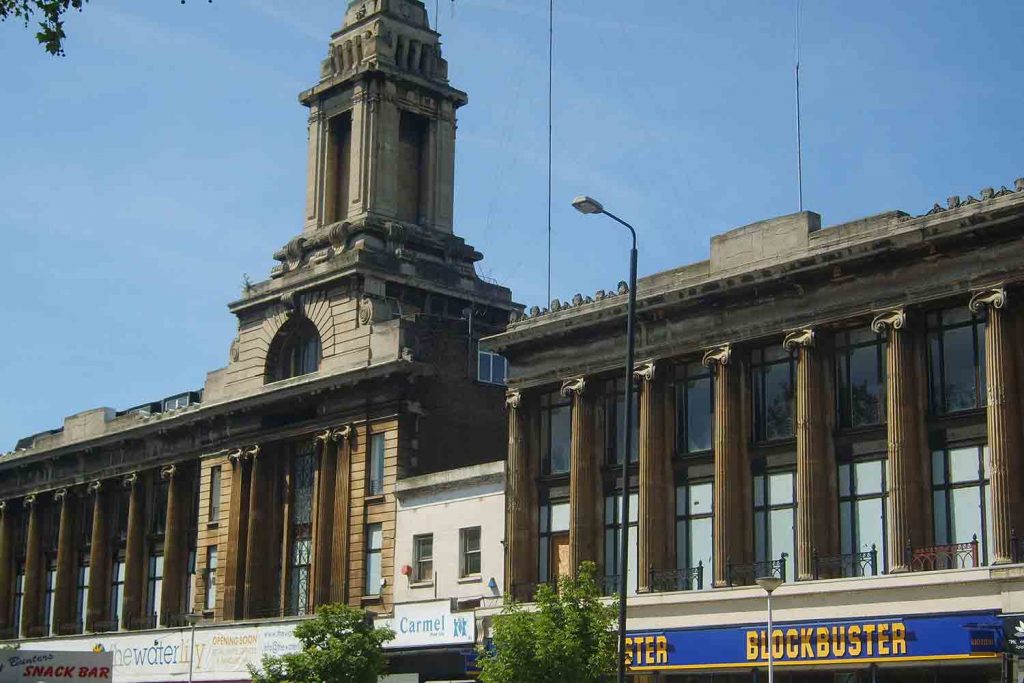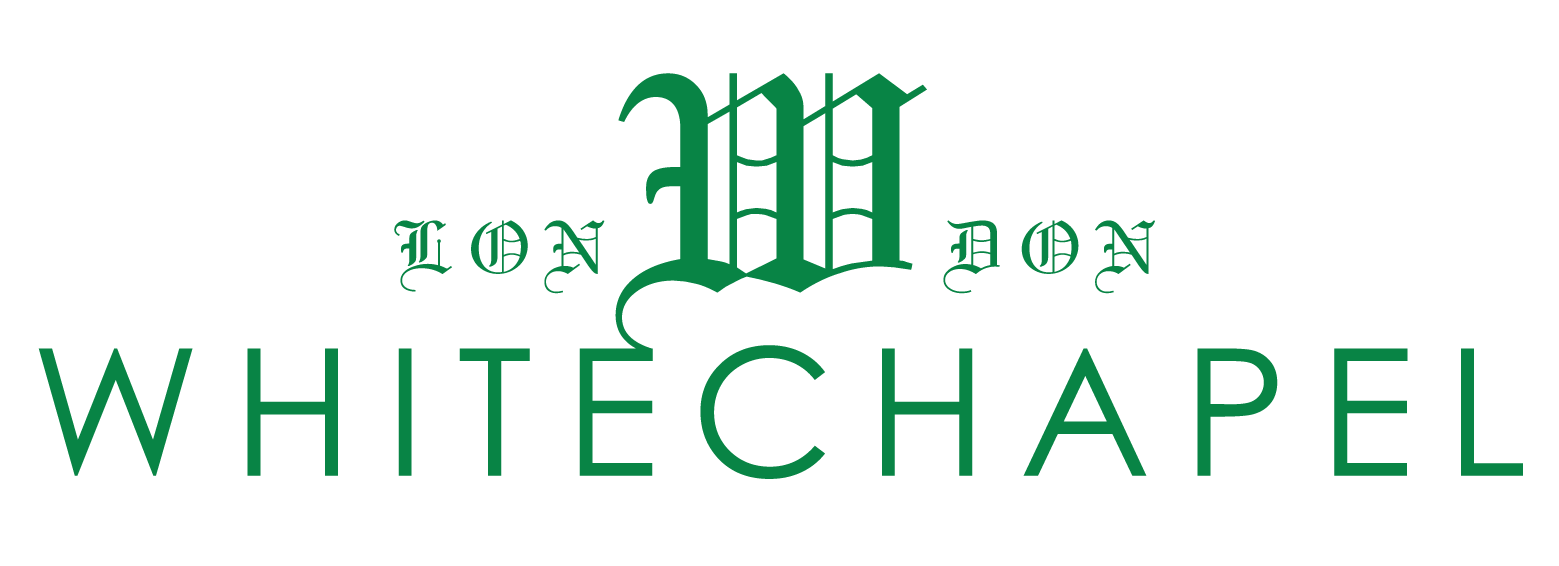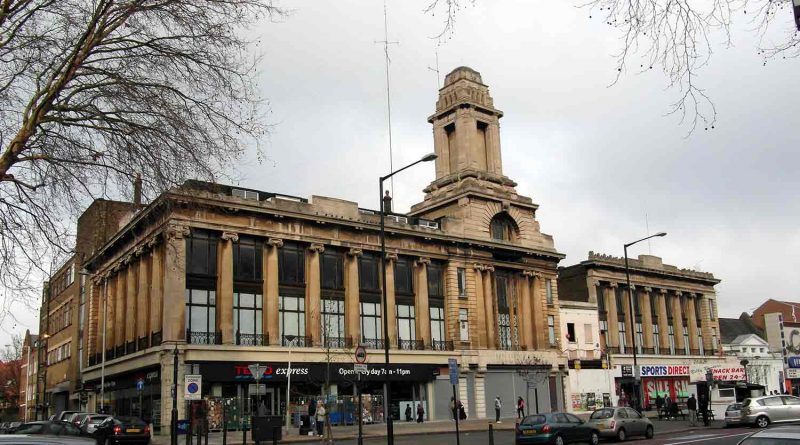Wickham’s department store: the architectural oddity once known as the Harrods of the East End
Once the East End’s most upmarket shopping destination, the peculiar-looking building holds a secret history of family feuds and rifts between locals and big business.
The building that spans 69-89 Mile End Road looks more like it should belong on the streets of nineteenth-century Paris than here in the East End. Between Stepney Green and Whitechapel stations, the classical Beaux-Arts structure is embedded into the high street. You wouldn’t guess that the building was once Wickham’s Department store, known as the ‘Harrods of the East End’ and holds a hidden history of family feuds and gentrification dating back to the early 20th century.
From Whitechapel Market to Petticoat Lane, our area is known for its mercantile flare. The rapid industrial and commercial boom of the nineteenth century revolutionised the high street into an upmarket destination and introduced a wave of department stores opening across Europe and the US. Harrods moved from Stepney to Knightsbridge in 1849 and Selfridges was opened later in 1909. At the height of the growing trend, the East End had its very own department store called ‘Wickham’s’, built in 1927 and located on Mile End Road.
Family feuds
The story of Wickham’s begins with a family of drapers originally from Kent who traded at 69, 71, and 73 Mile End Road. The Wickhams family saw the growing market potential of the East End and had ambitions to develop a department store that rivalled those in the centre of the city.
The family commissioned T, Jay Evans & Son, an architectural company, to design a building that would inhabit 20 stores on Mile End Road. Though it was later known as the Harrods of the East End, the design intended to mimic the structure of Selfridges with its colonnade front-facing style. The building even includes a central tower and clock that Gordon Selfridge originally planned but never achieved.
The building contract was signed and after long negotiations, businesses agreed to sell their lot to the Wickhams. But the plans were abruptly halted by one store that absolutely would not sell up – Spiegelhalter’s, a jewellery and watchmaking business at number 81.
The Spiegelhalter family were German immigrants and local business owners who made their home in the East End. In 1828, George Spiegelhalter immigrated from South West Germany to Whitechapel and established a jeweller, named after their family title.
Due to anti-german sentiment throughout the First World War, the family changed their name from Spiegelhalter to Salter in 1919 but their shop kept the original title. As business grew, Speigelhalters moved to 75 Mile End Road where the three Spiegelhalter brothers were born above the store and would eventually take over from their father.
It was around this time that Wickham’s interest in commercial growth was driving out local business on Mile End Road. Faced with the Wickham’s expansion, the Spiegelhalter brothers gave in a little and agreed to move from 75 to 81 in 1892 so that the family from Kent could extend their plot.
By 1927, the Wickhams had almost absorbed the block except number 81, owned by the Spiegelhalters. A mutually agreeable price was never reached between the families as the Spiegelhalter brothers remained adamant that they would not sell their business under any circumstances.
The mouth with the missing tooth
With building plans for the department store close to underway, the grand Wickham’s design was subject to quick reconsideration. What was built can only be described as the mouth with the missing tooth on Mile End Road. With seven windows bordering each side of the clock tower, the gaping dip in the structure where the Spiegelhalters held their ground, gave the building a distinct asymmetrical shape.
Some consider the building to be an architectural eyesore, others praise it as a mistake of genius. Famous mid-century architectural critic Ian Nairn described it as ‘one of the best visual jokes in London’.
The Spiegelhalters resumed their trade as usual, existing somewhat like a Chinese nail house on Mile End Road. Though the jeweller was dwarfed by the department store structure surrounding it, Spiegelhalter’s excelled when it came to attracting business.
Following the post-war economic crisis, Wickham’s was sold to Great Universal Stores in 1951 who owned the business until 1965, after which it was divided up between several different occupiers. The Spiegelhalters on the other hand, held onto their business until 1982 and their predecessors turned the store into an off-license.

History repeats itself
By 2014, the Spiegelhalter-Wickham conglomerate was mostly an abandoned, derelict building on Mile End Road, with a Tesco Express and Sports Direct renting the ground floor. Until it caught the eye of Resolution Property, a property development company that planned to transform it into an office space, replacing the missing tooth with a glass atrium entrance.
Over 30 years since the Speigelhalters sold their business, the property once again risked demolition at the mercy of giant investors. This time, it was the help of local community campaigning that saved Speigelhalters against the force of big business.
In January 2015, a petition supported by the Victorian Society and the Twentieth Century Society surfaced online. The aim was to push Tower Hamlets Council planning department to place the building on the local list to ensure the charm of the structure was preserved.
Like wildfire, the petition garnered over 2,700 signatures and even caught wind of national news outlets such as the BBC and the Financial Times. The story captured the age-old David and Goliath trope whilst calling into question how the integrity of local history can be kept alive in an age of rampant gentrification.
Though hopeful in their aims for modernisation, Resolution Property doubled down on their initial plans to remove the Speigelhalter facade after being faced with a wave of local and national resistance. Instead, they remodelled the building so that the first floor of the Spiegelhalter shop formed an archway over the entrance, finding a way to incorporate the old into the new.
Forward six years later, the reconstruction of Wickham’s was re-opened in September 2021 as ‘Dept W’, now belonging to Queen Mary University of London. Close to a century since it was built, you can still visit the building which was once the Harrods of the East End on Mile End Road. Though you’ll struggle to find any luxury department store goods if you look close enough above the entrance you can spot the original moniker ‘Spiegelhalter & Bros LTD’ where the family jewellers first opened in 1880.
They say history repeats itself and this may be the case for this local tale. What’s certain is that the Wickham’s building is distinguishable not only for its bizarre appearance but also for the legacy left behind.
If you are interested in the backstory of other local shopping destinations, check out the history of Whitechapel Market.


Lived in Bethnal Green when growing up and walked past this building hundreds of times and never knew it was once a department store aka The Harrods of the East End.
I remember Wickham’s very well during the 1950s when I lived on Cambridge Heath Road. It was not exactly ‘The Harrods of the East End’, but it was still a nice store. I remember the noise I made walking on the wooden floor. I could still tell that it was once a beautiful building.
I have written about the store on my website at: https://stories-of-london.org/youth/ (you will need to scroll down the page a little).
There are a number of wonderful buildings and monuments along the Mile End and Whitechapel Roads, but TOWER HAMLETS do not seem to care about them.
Interesting Freudian slip, that the Spiegelhalters turn into haters several times…(Definitely halter in the original building)